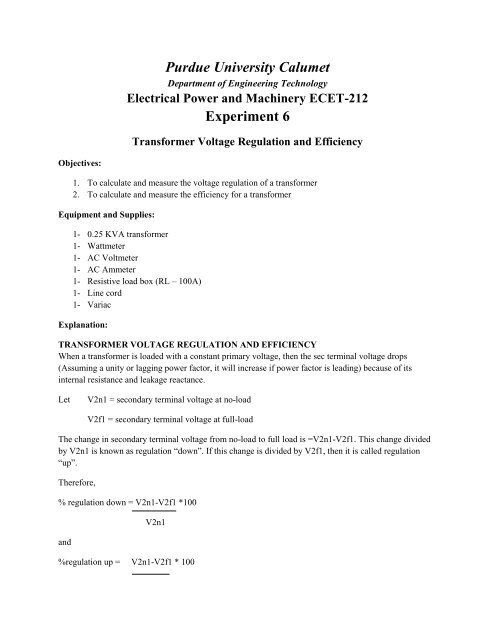EXPERIMENT 6 Transformer Voltage Regulation and Efficiency
EXPERIMENT 6 Transformer Voltage Regulation and Efficiency
EXPERIMENT 6 Transformer Voltage Regulation and Efficiency
You also want an ePaper? Increase the reach of your titles
YUMPU automatically turns print PDFs into web optimized ePapers that Google loves.
Purdue University Calumet<br />
Department of Engineering Technology<br />
Electrical Power <strong>and</strong> Machinery ECET-212<br />
Experiment 6<br />
<strong>Transformer</strong> <strong>Voltage</strong> <strong>Regulation</strong> <strong>and</strong> <strong>Efficiency</strong><br />
Objectives:<br />
1. To calculate <strong>and</strong> measure the voltage regulation of a transformer<br />
2. To calculate <strong>and</strong> measure the efficiency for a transformer<br />
Equipment <strong>and</strong> Supplies:<br />
1- 0.25 KVA transformer<br />
1- Wattmeter<br />
1- AC Voltmeter<br />
1- AC Ammeter<br />
1- Resistive load box (RL – 100A)<br />
1- Line cord<br />
1- Variac<br />
Explanation:<br />
TRANSFORMER VOLTAGE REGULATION AND EFFICIENCY<br />
When a transformer is loaded with a constant primary voltage, then the sec terminal voltage drops<br />
(Assuming a unity or lagging power factor, it will increase if power factor is leading) because of its<br />
internal resistance <strong>and</strong> leakage reactance.<br />
Let<br />
V2n1 = secondary terminal voltage at no-load<br />
V2f1 = secondary terminal voltage at full-load<br />
The change in secondary terminal voltage from no-load to full load is =V2n1-V2f1. This change divided<br />
by V2n1 is known as regulation “down”. If this change is divided by V2f1, then it is called regulation<br />
“up”.<br />
Therefore,<br />
% regulation down = V2n1-V2f1 *100<br />
<strong>and</strong><br />
V2n1<br />
%regulation up = V2n1-V2f1 * 100
V2f1<br />
In further treatment, unless stated otherwise, regulation is to be taken as regulation down. The lower the<br />
regulation the better the transformer, because a good transformer should keep its secondary terminal<br />
voltage as constant as possible under all conditions of load.<br />
LOSSES IN A TRANSFORMER<br />
(i)<br />
Core or iron loss: It includes both hysteresis loss <strong>and</strong> eddy current loss. Because the core flux<br />
in a transformer remains practically constant for all loads (its variation being 1 to 3 % from<br />
no-load to full load). Hence the core loss is practically the same at all loads.<br />
These losses are minimized by using steel of high silicon content for the core <strong>and</strong> by using<br />
very thin laminations. Core iron is found from the open-circuit test. The input of the<br />
transformer when on no load measure the core loss.<br />
(ii)<br />
Copper loss: This loss is due to the ohmic resistance of the transformer windings. Total<br />
copper loss = I1 2 R1 + I2 2 R2. It is clear that copper loss is proportional to (current) 2 or<br />
kVA2. In other words, copper loss at half the full-load is one-fourth of that at full-load.<br />
The value of copper loss is found from the short-circuit test.<br />
EFFICIENCY OF A TRANSFORMER:<br />
The efficiency of a transformer at a particular load <strong>and</strong> power factor is defined as the output divided by<br />
the input.<br />
<strong>Efficiency</strong> = Output<br />
Input<br />
But a transformer being a highly efficient piece of equipment, has a very small loss, hence it is<br />
impractical to try to measure eff by measuring input <strong>and</strong> output. A better method is to determine the<br />
losses <strong>and</strong> then calculate the efficiency from<br />
<strong>Efficiency</strong> =<br />
Output<br />
Output + losses<br />
Output<br />
Output + copper loss + core loss<br />
It may be noted here that efficiency is based on power output in watts <strong>and</strong> not in volt-amperes, although<br />
losses are proportional to VA. Hence at any volt-ampere load, the eff depends on power factor, being<br />
maximum at a power factor of unity.<br />
<strong>Efficiency</strong> =<br />
V2 I2 cos θ<br />
V2 I2 cos θ + copper loss + core loss
PROCEDURE:<br />
VOLTAGE REGULATION<br />
1. Calculate the % regulation for the 0.25KVA transformer when loaded to rated conditions use the<br />
value of Rp <strong>and</strong> Xp measured in the last laboratory experiment..<br />
2. Set up the circuit as in Fig. 1.<br />
3. Energize the transformer <strong>and</strong> adjust the load for rated current.<br />
NOTE: To avoid overheating do no energize for long periods of time.<br />
4. Measure the secondary voltage under full load.<br />
5. Disconnect the load resistor from the circuit <strong>and</strong> measure the secondary voltage with no load.<br />
6. Calculate the percent regulation <strong>and</strong> compare it to the theoretical regulation.<br />
TRANSFORMER EFFICIENCY<br />
1. Calculate the efficiency for rated unity power factor load. Use the measured values of the core<br />
<strong>and</strong> copper losses from the last laboratory experiment.<br />
2. Set up the circuit of Fig. 2.<br />
3. Set the load for rated load current.<br />
4. Measure the input power.<br />
5. Calculate the output power from the measured values of secondary voltage <strong>and</strong> current.<br />
6. Calculate the efficiency for the transformer as power out over power in.<br />
7. Compare the measured <strong>and</strong> theoretical results.
8. Load the transformer in steps from 0 to 100% of rated current. Measure the output voltage <strong>and</strong><br />
current.<br />
9. For each of the load do the following:<br />
1. Calculate the power output = V 2 I 2 cos θ<br />
2. Calculate copper loss = I 2 2 R s<br />
3. Calculate the efficiency = Power Output<br />
Power output + Pcore + P copper<br />
4. Make a plot of copper loss, core loss <strong>and</strong> efficiency against the %load on the same coordinate<br />
system.<br />
5. Locate the peak efficiency point <strong>and</strong> verify that this point occurs when copper loss equals<br />
core loss.<br />
EXTRA CREDIT:<br />
Write a computer program to do the above steps.<br />
η = P out = V 2 I 2 cos θ<br />
P out + P losses<br />
V 2 I 2 cosθ + P core + I 2 2 R s

















